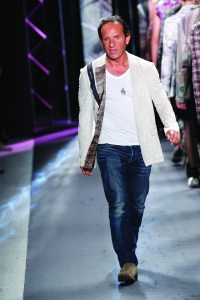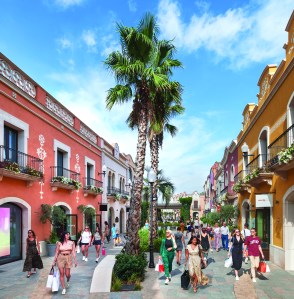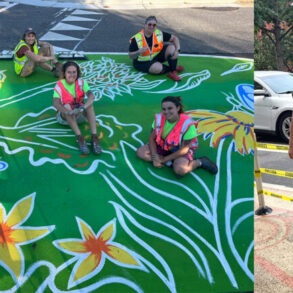Barcelona, a vibrant metropolis on the Mediterranean coast of Spain, has emerged as a significant global fashion hub. Its unique blend of culture, history, and artistic heritage has fostered a creative environment that inspires designers and captivates consumers worldwide.
For Alex Badia, Style Director at WWD, Barcelona offers pure inspiration — and also something personal. It’s Badia’s birthplace.
“Sometimes I feel that I’m too close to it to be objective,” he said. “But the facts are the facts. Barcelona has always been a cultural center for art, architecture and fashion. That’s its legacy.” Badia admits that as a youth, he often took Barcelona for granted. “But when I go back there now, I look at the scene, and experience the fashion, culture, art and its offerings to shop — and I think, ‘oh my, this is incredible!’”

Balenciaga fall 1965 Ready to Wear Fashion Show and Backstage.
FAIRCHILD ARCHIVE
Badia said Barcelona’s fashion story traces back to the early 20th century when its thriving textile industry enabled local designers to produce exquisite garments. The city’s connection to Parisian fashion, along with its strong textile and embroidery traditions, contributed to its rise as a fashion destination. Renowned designers such as Jeanne Lanvin recognized Barcelona’s potential, opening a branch of her store there in 1929.
You May Also Like
Barcelona has a long history of textile production and fashion design, dating back to the early 20th century. Designers like Cristóbal Balenciaga and Paco Rabanne have emerged from the city, establishing its reputation as a fashion hub. Balenciaga’s legacy is seen in the work of many high-profile designers who openly acknowledge his influence. His bold, forward-thinking approach is evident in the works of designers such as Oscar de la Renta, André Courrèges and Hubert de Givenchy, to name a few. Givenchy revered him as “the master of us all,” while others in the fashion world still study his techniques and approaches to learn about structure, cut and fabric use.

Model Debra Shaw on the runway at Paco Rabanne Final fall 1999 Couture Show in Paris.
GIOVANNI GIANNONI
Paco Rabanne, a name synonymous with boldness and innovation, has etched an indelible mark on the landscape of international fashion. Rabanne’s pioneering work redefined conventional notions about materials in apparel design. Known distinctively for using unconventional elements such as metal, paper and plastic, Rabanne ventured beyond the traditional fabric-based approach to create wearable art. His debut collection in 1966, titled “12 Unwearable Dresses in Contemporary Materials,” showcased these innovative choices, turning heads with metal-linked mini dresses and chain-mail inspired garments that captured a futuristic and architectural aesthetic.
Today, Barcelona boasts a vibrant fashion industry with numerous fashion houses, ateliers and design schools. The city hosts the 080 Barcelona Fashion Week, showcasing the latest collections from both established and emerging designers. Fashion schools and design institutions, such as the Escola Superior de Disseny i Enginyeria Textil de Terrassa (ESDi), also contribute to the city’s fashion ecosystem. Barcelona designers who are making waves in the international fashion scene include Custo Barcelona, Mango and Desigual — all have gained global recognition for their innovative designs and trendy collections.

Balenciaga spring 2019 Ready to Wear Runway Show in Paris on September 30, 2018.
SWAN GALLET/WWD
Barcelona’s rich cultural tapestry, deeply rooted in Catalan tradition, plays a pivotal role in shaping its fashion identity. The city’s vibrant street life, characterized by a relaxed yet stylish atmosphere, inspires designers to create collections that reflect the local aesthetic. The Catalan people’s appreciation for quality craftsmanship and attention to detail are evident in the meticulous construction and innovative designs of Barcelona-based fashion brands. City residents are known for their stylish and effortless dressing sense, often incorporating bold colors, patterns and accessories, Badia said, adding that Barcelona is an established hub for design and innovation, with a strong focus on sustainability and ethical practices.
Barcelona’s artistic heritage, particularly its renowned architecture and artistic movements, significantly influences fashion design. The city’s iconic landmarks, such as Antoni Gaudí’s Sagrada Família and Park Güell, serve as sources of inspiration for designers, who draw on their intricate details, vibrant colors, and organic forms to create unique and visually striking garments.

Designer Custo Dalmau walks the finale Custo Barcelona spring 2012 show at Lincoln Center’s Stage in New York.
HOMAS IANNACCONE
Badia said the city’s contemporary art scene, with its diverse range of galleries and museums, further stimulates creativity and fosters a forward-thinking approach to fashion. Badia described the city as being infused with creativity. “In the 1990s and 2000s, there was a boom of creativity in terms of advertising and product creation; and there was a lot of think tanks happening in Barcelona,” he said. “Every now and then there is a cultural revolution there, and then it goes, and it becomes dormant again. Like through political power, through tourism, there is that pull-push-pull.”
For tourists, Barcelona is a perfect place to visit. “But you need to walk around the city,” Badia said. “You need to always look around, never look down, look up at the buildings, look around you — because art is everywhere.” Badia said Barcelona as a shopping destination is more relevant than ever, “because it’s about music. It’s about architecture, it’s about interior design. It’s about product design, it’s about food, and then of course, it’s about fashion.” Badia described Barcelona as a city that is ever-changing where the new and the old interact. He said Barcelona’s unique blend of culture, history and art has also positioned it as a dynamic and influential fashion city. Its rich heritage, vibrant street style and innovative design scene continue to inspire designers and captivate consumers worldwide. As Barcelona embraces the future of fashion, it remains committed to its roots while pushing the boundaries of creativity and sustainability.
La Roca Village, part of the Bicester collection, Sets New Standards in Luxury Shopping and Cultural Fusion
Just outside Barcelona, La Roca Village offers more than boutique shopping — it’s a vibrant blend of fashion, art, and immersive experiences that engage all senses.

La Roca Village near Barcelona is setting a new benchmark in boutique shopping. La Roca Village, known for its unique blend of cultural vibrancy and exclusive shopping, offers more than just a traditional retail experience; it provides an immersive journey that appeals to all senses.
A New Era of Shopping: Experiential Luxury
The shift among consumers towards more in-store, experiential shopping experiences is at the heart of today’s luxury shopping experience. “In today’s environment, luxury shoppers are increasingly attracted to experiences that offer emotional connections — not just transactions,” said Harry Tremaine from La Roca Village who highlighted that consumers are looking for personalized attention, clienteling exceptional service, and engaging environments that foster a sense of exclusivity and community.
Situated just outside the cosmopolitan city of Barcelona, La Roca Village captivates its visitors with an open-air, modernist landscape-inspired environment featuring over 150 boutiques from leading international and Spanish brands. La Roca Village goes beyond mere shopping; it’s an amalgamation of gastronomy, art and culture. The Village not only offers year-round savings on high-end brands but also hosts cultural events and art installations, enriching the shopping experience.
Barcelona’s role in shaping La Roca Village into a luxury shopping destination is born from the city’s vibrant culture, rich history and cosmopolitan atmosphere — which enhance the allure of La Roca Village. The city’s reputation as a hub for art, gastronomy and fashion naturally extends to the Village, making it a must-visit destination for both local and international visitors.
La Roca Village: A Unique Fashion City
Distinct from other shopping destinations, La Roca Village offers a relaxed yet vibrant atmosphere that blends urban fashion excitement with the tranquility sought by visitors. “La Roca Village is not just a shopping destination; it’s a Fashion City where retail and hospitality intersect,” Tremaine said. The Village regularly hosts events and exhibitions, such as the current “Many Faces of Gala,” turning it into a cultural hub that appeals to contemporary luxury consumers.
La Roca Village’s seamless integration of fashion, art and dining, coupled with its traffic-free, serene setting, allows visitors to enjoy the perks of city shopping without the typical chaos, providing an ideal retreat for those seeking both excitement and relaxation.
La Roca Village continues to redefine the concept of luxury shopping, merging cultural enrichment with high-quality retail in one of the world’s most dynamic cities.
This post was originally published on this site be sure to check out more of their content







